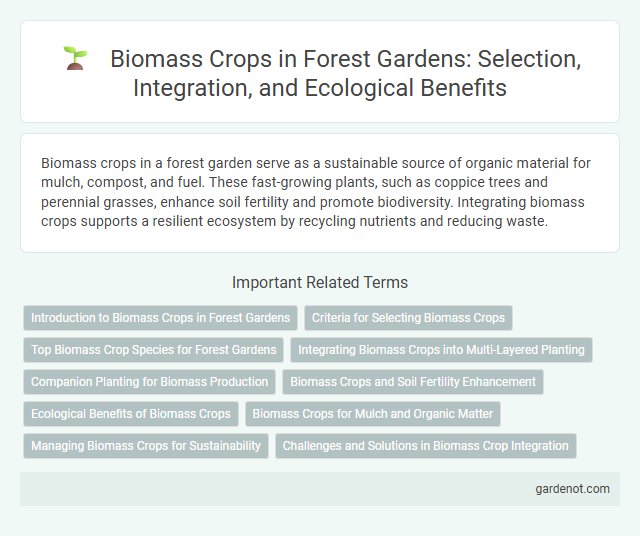Biomass crops in a forest garden serve as a sustainable source of organic material for mulch, compost, and fuel. These fast-growing plants, such as coppice trees and perennial grasses, enhance soil fertility and promote biodiversity. Integrating biomass crops supports a resilient ecosystem by recycling nutrients and reducing waste.
Introduction to Biomass Crops in Forest Gardens
Biomass crops in forest gardens are fast-growing plants cultivated primarily for organic material production, contributing to sustainable energy and soil health. These crops, such as willow, miscanthus, and poplar, efficiently capture carbon dioxide and enhance biodiversity while providing renewable resources for biofuel and mulch. Integrating biomass crops within forest gardens supports carbon sequestration, promotes habitat diversity, and offers economic benefits through low-input biomass harvesting.
Criteria for Selecting Biomass Crops
Selecting biomass crops for forest gardens requires considering growth rate, yield capacity, and compatibility with local soil and climate conditions. High lignocellulosic content and low maintenance demands enhance sustainability and energy output efficiency. Resistance to pests and diseases ensures long-term productivity and minimal environmental impact.
Top Biomass Crop Species for Forest Gardens
Poplar, willow, and miscanthus dominate as top biomass crop species for forest gardens due to their rapid growth rates and high carbon sequestration capacity. These species contribute significantly to sustainable energy production by providing abundant organic material for bioenergy applications. Integrating such biomass crops enhances forest garden biodiversity while promoting soil health and ecosystem resilience.
Integrating Biomass Crops into Multi-Layered Planting
Integrating biomass crops into multi-layered planting within forest gardens enhances sustainable biomass production by utilizing vertical space and promoting biodiversity. Species such as fast-growing willow, miscanthus, and switchgrass can be cultivated beneath taller fruit or nut trees, optimizing light capture and soil nutrients. This approach not only increases overall yield but also improves carbon sequestration and soil health through diverse root structures and organic matter inputs.
Companion Planting for Biomass Production
Companion planting in forest gardens enhances biomass crop yield by promoting symbiotic relationships between diverse plant species, optimizing nutrient cycling and soil fertility. Integrating nitrogen-fixing plants such as clover or lupins with fast-growing biomass species like willow or poplar increases overall biomass production while reducing the need for synthetic fertilizers. This approach supports sustainable biomass harvesting, improves ecosystem resilience, and boosts long-term carbon sequestration.
Biomass Crops and Soil Fertility Enhancement
Biomass crops in forest gardens enhance soil fertility by increasing organic matter and promoting nutrient cycling through deep root systems and leaf litter decomposition. These crops, such as switchgrass and miscanthus, contribute to improved soil structure and microbial activity, supporting long-term soil health. Integrating biomass crops with nitrogen-fixing plants further optimizes nutrient availability and reduces the need for synthetic fertilizers.
Ecological Benefits of Biomass Crops
Biomass crops in forest gardens enhance soil fertility by increasing organic matter and promoting microbial biodiversity, which supports nutrient cycling and ecosystem resilience. These crops contribute to carbon sequestration, reducing greenhouse gas emissions and mitigating climate change impacts. Root systems of biomass crops improve soil structure, decrease erosion, and foster water retention, sustaining overall ecosystem health.
Biomass Crops for Mulch and Organic Matter
Biomass crops such as comfrey, millet, and sweet potatoes provide abundant organic matter crucial for mulch in forest gardens, enhancing soil fertility and moisture retention. These crops rapidly produce large amounts of biomass that can be chopped and dropped to suppress weeds and improve soil structure. Incorporating biomass crops accelerates nutrient cycling, fostering a sustainable ecosystem that supports diverse plant growth and increases overall garden productivity.
Managing Biomass Crops for Sustainability
Managing biomass crops in forest gardens enhances sustainability by promoting biodiversity, improving soil health, and reducing carbon emissions. Strategic harvesting schedules and selecting native species optimize biomass yield while preserving ecosystem balance. Integrating biomass crops with other polyculture elements supports nutrient cycling and long-term productivity.
Challenges and Solutions in Biomass Crop Integration
Biomass crop integration in forest gardens faces challenges such as soil nutrient depletion, pest management, and competition with native plants. Implementing crop rotation, using biofertilizers, and selecting pest-resistant species help mitigate these issues effectively. Precision monitoring and adaptive management further enhance sustainable biomass production in forest garden systems.
Biomass crop Infographic

 gardenot.com
gardenot.com